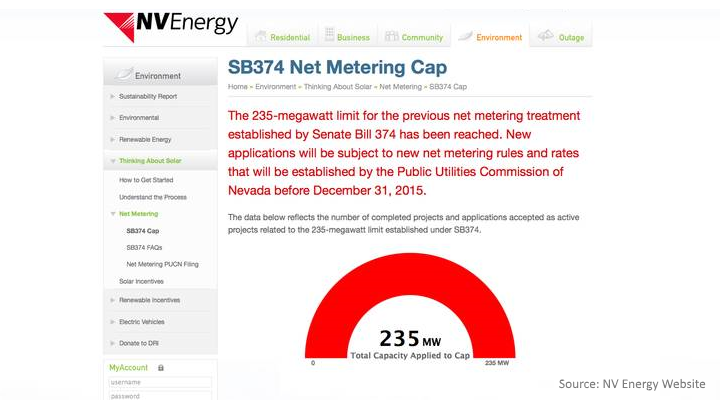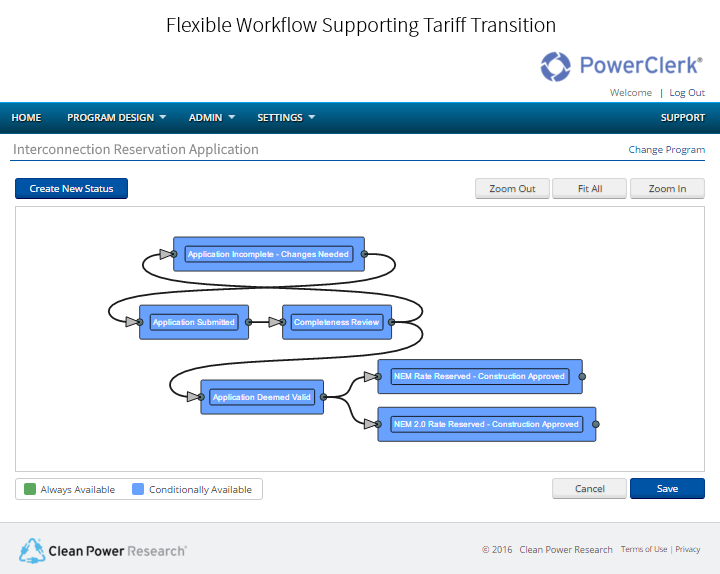As recently reported by GTM Research, the volume of distributed solar photovoltaic (PV) systems on American homes and businesses is continuing its rapid climb—with the residential solar market growing 66% in 2015 over 2014. This growth can be attributed to a variety of factors, including cheaper equipment and installation costs, the extension of the Investment Tax Credit (ITC) on the federal level, and rebate or performance-based incentives at the state- or utility-level.
Rate options such as net energy metering (NEM) tariffs have also played an important role in continued solar growth, providing favorable economics for home and business owners. Like the ITC and incentives, the availability of NEM tariffs are often constricted by time limits or utility or statewide caps. This puts a lot of pressure on utilities to closely track how close they are to reaching NEM caps, and to keep their home and business customers informed about whether or not they will qualify for a particular NEM tariff—before a decision is made to install a PV system.
With the steep growth in distributed PV, many utilities are finding themselves challenged to efficiently manage the transition from one rate to another. This leads to surprised customers who learn too late that their newly installed PV system is not going to be on the expected NEM tariff. Customer frustration can set in quickly when it becomes apparent that a tariff change is impacting return on investment.
To avoid this scenario, it’s imperative that utilities implement interconnection processes that build-in transparency well before net metering caps are reached. In effect, vaccinating themselves against disappointing customers and other stakeholders when transitioning to new electric tariffs.
Preparing ahead for net energy metering transitions
When NEM tariffs are established, caps are often set by utility commissions that limit the total volume of net-metered generation as a percentage of the utility’s peak load. One common practice we’ve observed is the simultaneous approval of the net metering rate and permission to operate (PTO) the interconnected PV system. This inevitably leads to a scenario where the NEM tariff cap is reached after a PV system has been sold and constructed, but before PTO has been provided.
In that case, the home or business owner would be placed on a different (non-NEM) rate structure, which can impact the economics of operating the PV system.
Strategies for building-in transparency
One way utilities can avoid surprising customers is to implement a reservation system or queue for the net-metering tariff earlier in the interconnection process, likely before the PV system has been procured. Then, as the cap is neared, the utility can process applications in the order in which they were received, and notify each applicant of their approved tariff before construction of a PV system begins.
In order to provide this level of transparency, the queue position of each application should be clearly visible to its applicant and automatically updated in real-time as other projects exit the queue. Additionally, the use of public-facing dashboards that graphically demonstrate the remaining capacity running against the tally of approved projects can be very valuable. An example is the NV Energy SB374 Net Metering Cap tracker, shown below, which was updated as applications are submitted.

In a 2014 report released by SEPA, “Distributed Solar Interconnection Challenges and Best Practices,” the second most difficult interconnection challenge reported by utilities managing distributed solar was communicating with customers. Online administration systems such as PowerClerk® take full advantage of the latest technologies to provide greater transparency to applicants (both utility customers and installers/contractors) and administrators alike.
To maintain high levels of transparency, administrators should be able to rapidly implement process evolutions (such as changes to forms and workflow) as tariffs are modified or phased out. The ability to automatically track projects in a queue, show real-time queue position, notify applicants of changes to tariff eligibility and feed real-time information into public-facing dashboards play a critical role in ensuring customers are able to make informed decisions about purchasing a PV system—and keep customer satisfaction levels high.

Uninformed stakeholders are angry stakeholders
As the ever-rising tide of distributed PV pushes NEM programs to their caps, the urgency of the discussion around what should happen to net metering grows. In fact, a recent Greentech Media article indicated that more than half of U.S. states are studying or changing net metering policies.
As the industry grapples with questions about the future of NEM, utilities should strongly consider implementing processes that can rapidly adapt to these changes, and keep interconnection stakeholders informed throughout the transition to a non-NEM tariff or a NEM-successor. The prescription for success is to get ahead of this problem before caps are hit and stakeholders are caught unaware.
